NCERT Solutions | Class 12 Maths Chapter 6 | Application of Derivatives

CBSE Solutions | Maths Class 12
Check the below NCERT Solutions for Class 12 Maths Chapter 6 Application of Derivatives Pdf free download. NCERT Solutions Class 12 Maths were prepared based on the latest exam pattern. We have Provided Application of Derivatives Class 12 Maths NCERT Solutions to help students understand the concept very well.
NCERT | Class 12 Maths
| Book: | National Council of Educational Research and Training (NCERT) |
|---|---|
| Board: | Central Board of Secondary Education (CBSE) |
| Class: | 12th |
| Subject: | Maths |
| Chapter: | 6 |
| Chapters Name: | Application of Derivatives |
| Medium: | English |
Application of Derivatives | Class 12 Maths | NCERT Books Solutions
NCERT Solutions for Class 12 Maths Chapter 6 Application of Derivatives Ex 6.1
Ex 6.1 Class 12 Maths Question 1.
Find the rate of change of the area of a circle with respect to its radius r when (a) r = 3 cm (b) r = 4 cm
Solution.
Let A be the area of the circle
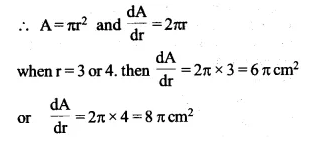
Ex 6.1 Class 12 Maths Question 2.
The volume of a cube is increasing at the rate of 8 cm³/s. How fast is the surface area increasing when the length of an edge is 12 cm?
Solution.
Let x be the length of the cube volume V = x³,
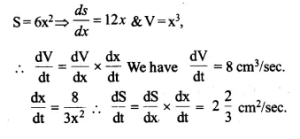
Ex 6.1 Class 12 Maths Question 3.
The radius of a circle is increasing uniformly at the rate of 3 cm/s. Find the rate at which the area of the circle is increasing when the radius is 10 cm.
Solution.
Let r be the radius of the circle.
Area of circle = πr² = A also \(\frac { dr }{ dt }\) = 3 cm/ sec.

Ex 6.1 Class 12 Maths Question 4.
An edge of a variable cube is increasing at the rate of 3 cm/s. How fast is the volume of the cube increasing when the edge is 10 cm long?
Solution.
Let the edge of the cube = x cm
∴ \(\frac { dx }{ dt }\) = 3

Ex 6.1 Class 12 Maths Question 5.
A stone is dropped into a quiet lake and waves move in circles at the speed of 5 cm/s. At the instant when the radius of the circular wave is 8 cm, how fast is the enclosed area increasing?
Solution.
Let r be the radius of a wave circle: \(\frac { dx }{ dt }\) = 5cm/sec.

Ex 6.1 Class 12 Maths Question 6.
The radius of a circle is increasing at the rate of 0.7 cm/s. What is the rate of increase of its circumference?
Solution.
The rate of change of circle w.r.t time t is given
to be 0.7 cm/sec. i.e. \(\frac { dr }{ dt }\) = 0.7 cm/sec.
Now, circumference of the circle is c = 2πr
\(\therefore \frac { dc }{ dt } =\left[ \frac { d }{ dr } \left( 2\pi r \right) .\frac { dr }{ dt } \right] =2\pi \frac { dr }{ dt } =1.4\pi cm/sec\)
Ex 6.1 Class 12 Maths Question 7.
The length x of a rectangle is decreasing at the rate of 5 cm/minute and the width y is increasing at the rate of 4 cm/minute. When x = 8 cm and y = 6 cm, find the rates of change of
(a) the perimeter, and
(b) the area of the rectangle.
Solution.
(a) The length x of a rectangle is decreasing at dx the rate of 5cm/min. => \(\frac { dx }{ dt }\) = – 5cm min …(i)
The width y is increasing at the rate of 4cm/min.

Ex 6.1 Class 12 Maths Question 8.
A balloon, which always remains spherical on inflation, is being inflated by pumping in 900 cubic centimetres of gas per second. Find the rate at which the radius of the balloon increases when the radius is 15 cm.
Solution.
Volume of the spherical balloon = V = \(\frac { 4 }{ 3 } \pi { r }^{ 3 }\)
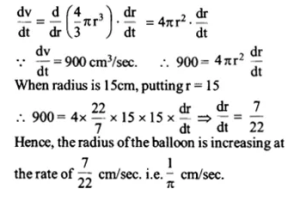
Ex 6.1 Class 12 Maths Question 9.
A balloon, which always remains spherical has a variable radius. Find the rate at which its volume is increasing with the radius when the later is 10 cm.
Solution.
Let r be the variable radius of the balloon which is in the form of sphere Vol. of the sphere

Ex 6.1 Class 12 Maths Question 10.
A ladder 5 m long is leaning against a wall. The bottom of the ladder is pulled along the ground, away from the wall, at the rate of 2cm/s. How fast is its height on the wall decreasing when the foot of the ladder is 4m away from die wall ?
Solution.
Let AB be the ladder and OB be the wall. At an instant,
let OA = x, OB = y,
x² + y² = 25 …(i)
On differentiating,
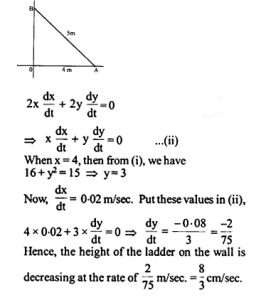
Ex 6.1 Class 12 Maths Question 11.
A particle moves along the curve 6y = x3 + 2. Find the points on the curve at which the y-coordinate is changing 8 times as fast as the x-coordinate.
Solution.
We have
6y = x3 + 2…(i)
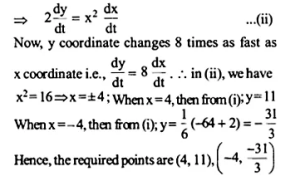
Ex 6.1 Class 12 Maths Question 12.
The radius of an air bubble is increasing at the rate of \(\frac { 1 }{ 2 }\) cm/s. At what rate is the volume of the bubble increasing when the radius is 1 cm?
Solution.
Let r be the radius then V = \(\frac { 4 }{ 3 } \pi { r }^{ 3 }\)
\(\frac { dr }{ dt } =\frac { 1 }{ 2 } cm/sec\)
\(\frac { dv }{ dt } =\frac { d }{ dt } \left( \frac { 4 }{ 3 } \pi { r }^{ 3 } \right) =\frac { 4 }{ 3 } { \pi .3r }^{ 2 }.\frac { dr }{ dt } ={ 2\pi r }^{ 2 }\)
Hence, the rate of increase of volume when radius is 1 cm = 2π x 1² = 2π cm3/sec.
Ex 6.1 Class 12 Maths Question 13.
A balloon, which always remains spherical, has a variable diameter \(\frac { 3 }{ 2 }(2x+1)\) . Find the rate of change of its volume with respect to x.
Solution.
Dia of sphere = \(\frac { 3 }{ 2 }(2x+1)\)
∴ Radius = \(\frac { 3 }{ 4 }(2x+1)\)

Ex 6.1 Class 12 Maths Question 14.
Sand is pouring from a pipe at the rate of 12 cm3/s. The falling sand forms a cone on the ground in such a way that the height of the cone is always one-sixth of the radius of the base. How fast is the height of the sand cone increasing when the height is 4 cm?
Solution.
Let r and h be the radius and height of the sand
– cone at time t respectively, h = \(\frac { r }{ 6 } \) …(i)

Ex 6.1 Class 12 Maths Question 15.
The total cost C (x) in Rupees associated with the production of x units of an item is given by C (x) = 0.007 x3 – 0.003 x2 + 15x + 4000. Find the marginal cost when 17 units are produced.
Solution.
Marginal cost MC = Instantaneous rate of change
of total cost at any level of out put = \(\frac { dC }{ dx } \)
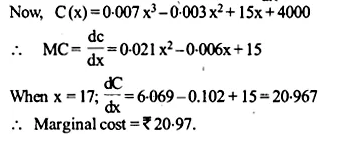
Ex 6.1 Class 12 Maths Question 16.
The total revenue in Rupees received from the sale of x units of a product is given by
R (x) = 13x² + 26x +15. Find the marginal revenue when x = 7.
Solution.
Marginal Revenue (MR)
= Rate of change of total revenue w.r.t. the
number of items sold at an instant = \(\frac { dR }{ dx } \)
We know R(x) = 13x² + 26x + 15,
MR = \(\frac { dR }{ dx } \) = 26x + 26 = 26(x+1)
Now x = 7, MR = 26 (x + 1) = 26 (7 + 1) = 208
Hence, Marginal Revenue = Rs 208.
Choose the correct answer in the Exercises 17 and 18.
Ex 6.1 Class 12 Maths Question 17.
The rate of change of the area of a circle with respect to its radius r at r = 6 cm is
(a) 10π
(b) 12π
(c) 8π
(d) 11π
Solution.
(b) ∵ A = πr² => \(\frac { dA }{ dr } \) = 2π x 6 = 12π cm²/radius
Ex 6.1 Class 12 Maths Question 18.
The total revenue in Rupees received from the sale of x units of a product is given by R (x) = 3x² + 36x + 5. The marginal revenue, when x = 15 is
(a) 116
(b) 96
(c) 90
(d) 126
Solution.
(d) R(x) = 3x² + 36x + 5 ,
MR = \(\frac { dR }{ dx } \) = 6x + 36 ,
At x = 15; \(\frac { dR }{ dx } \) = 6 x 15 + 36 = 90 + 36 = 126
NCERT Solutions for Class 12 Maths Chapter 6 Application of Derivatives Ex 6.2
Ex 6.2 Class 12 Maths Question 1.
Show that the function given by f (x) = 3x+17 is strictly increasing on R.
Solution.
f(x) = 3x + 17
∴ f’ (x) = 3>0 ∀ x∈R
⇒ f is strictly increasing on R.
Ex 6.2 Class 12 Maths Question 2.
Show that the function given by f (x) = e2x is strictly increasing on R.
Solution.
We have f (x) = e2x
⇒ f’ (x) = 2e2x
Case I When x > 0, then f’ (x) = 2e2x
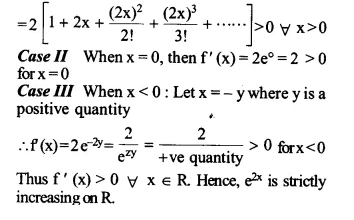
Ex 6.2 Class 12 Maths Question 3.
Show that the function given by f (x) = sin x is
(a) strictly increasing in \(\left( 0,\frac { \pi }{ 2 } \right) \)
(b) strictly decreasing in \(\left( \frac { \pi }{ 2 } ,\pi \right) \)
(c) neither increasing nor decreasing in (0, π)
Solution.
We have f(x) = sinx
∴ f’ (x) = cosx
(a) f’ (x) = cos x is + ve in the interval \(\left( 0,\frac { \pi }{ 2 } \right) \)
⇒ f(x) is strictly increasing on \(\left( 0,\frac { \pi }{ 2 } \right) \)
(b) f’ (x) = cos x is a -ve in the interval \(\left( \frac { \pi }{ 2 } ,\pi \right) \)
⇒ f (x) is strictly decreasing in \(\left( \frac { \pi }{ 2 } ,\pi \right) \)
(c) f’ (x) = cos x is +ve in the interval \(\left( 0,\frac { \pi }{ 2 } \right) \)
while f’ (x) is -ve in the interval \(\left( \frac { \pi }{ 2 } ,\pi \right) \)
∴ f(x) is neither increasing nor decreasing in (0,π)
Ex 6.2 Class 12 Maths Question 4.
Find the intervals in which the function f given by f(x) = 2x² – 3x is
(a) strictly increasing
(b) strictly decreasing
Solution.
f(x) = 2x² – 3x
⇒ f’ (x) = 4x – 3
⇒ f’ (x) = 0 at x = \(\frac { 3 }{ 4 }\)
The point \(x=\frac { 3 }{ 4 }\) divides the real
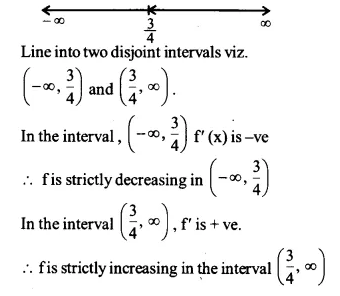
Ex 6.2 Class 12 Maths Question 5.
Find the intervals in which the function f given by f (x) = 2x3 – 3x² – 36x + 7 is
(a) strictly increasing
(b) strictly decreasing
Solution.
f(x) = 2x3 – 3x² – 36x + 7;
f (x) = 6 (x – 3) (x + 2)
⇒ f’ (x) = 0 at x = 3 and x = – 2
The points x = 3, x = – 2, divide the real line into three disjoint intervals viz. (-∞,-2), (-2,3), (3,∞)
Now f’ (x) is +ve in the intervals (-∞, -2) and (3,∞). Since in the interval (-∞, -2) each factor x – 3, x + 2 is -ve.
⇒ f’ (x) = + ve.
(a) f is strictly increasing in (-∞, -2)∪(3,∞)
(b) In the interval (-2,3), x+2 is +ve and x-3 is -ve.
f (x) = 6(x – 3)(x + 2) = + x – = -ve
∴ f is strictly decreasing in the interval (-2,3).
Ex 6.2 Class 12 Maths Question 6.
Find the intervals in which the following functions are strictly increasing or decreasing:
(a) x² + 2x – 5
(b) 10 – 6x – 2x²
(c) – 2x3 – 9x² – 12x + 1
(d) 6 – 9x – x²
(e) (x + 1)3(x – 3)3
Solution.
(c) Let f(x) = – 2x3 – 9x2 – 12x + 1
∴ f’ (x) = – 6x2 – 18x – 12
= – 6(x2 + 3x + 2)
f'(x) = – 6(x + 1)(x + 2), f’ (x) = 0 gives x = -1 or x = -2
The points x = – 2 and x = – 1 divide the real line into three disjoint intervals namely ( – ∞, – 2) ( – 2, – 1) and( – 1 ∞).
In the interval (-∞,-2) i.e.,-∞<x<-2 (x+ 1) (x+2) are -ve.
∴f’ (x) = (-) (-) (- ) = – ve.
⇒ f (x) is decreasing in (-∞,-2)
In the interval (-2, -1) i.e., – 2 < x < -1,
(x + 1) is -ve and (x + 2) is + ve.
∴ f'(x) = (-)(-) (+) = + ve.
⇒ f (x) is increasing in (-2, -1)
In the interval (-1,∞) i.e.,-1 <x<∞,(x + 1) and (x + 2) are both positive. f’ (x) = (-) (+) (+) = -ve.
⇒ f (x) is decreasing in (-1, ∞)
Hence, f (x) is increasing for – 2 < x < – 1 and decreasing for x<-2 and x>-1.
Ex 6.2 Class 12 Maths Question 7.
Show that \(y=log(1+x)-\frac { 2x }{ 2+x } x>-1\), is an increasing function of x throughout its domain.
Solution.
let \(f(x)=log(1+x)-\frac { 2x }{ 2+x } x>-1\)
f’ (x) = \(\frac { { x }^{ 2 } }{ { (x+1)(x+2) }^{ 2 } } \)
For f (x) to be increasing f’ (x) > 0
\(\Rightarrow \frac { 1 }{ x+1 } >0\Rightarrow x>-1\)
Hence, \(y=log(1+x)-\frac { 2x }{ 2+x } \) is an increasing function of x for all values of x > – 1.
Ex 6.2 Class 12 Maths Question 8.
Find the values of x for which y = [x (x – 2)]² is an increasing function.
Solution.
y = x4 – 4x3 + 4x2
∴ \(\frac { dy }{ dx }\) = 4x3 – 12x2 + 8x
For the function to be increasing \(\frac { dy }{ dx }\) >0
4x3 – 12x2 + 8x>0
⇒ 4x(x – 1)(x – 2)>0
For 0 < x < 1, \(\frac { dy }{ dx }\) = (+)(-)(-) = +ve and for x > 2, \(\frac { dy }{ dx }\) = (+) (+) (+) = +ve
Thus, the function is increasing for 0 < x < 1 and x > 2.
Ex 6.2 Class 12 Maths Question 9.
Prove that \(y=\frac { 4sin\theta }{ (2+cos\theta ) } -\theta \) is an increasing function of θ in \(\left[ 0,\frac { \pi }{ 2 } \right] \)
Solution.
\(\frac { dy }{ dx } =\frac { 8cos\theta +4 }{ { (2+cos\theta ) }^{ 2 } } -1=\frac { cos\theta (4-cos\theta ) }{ { (2+cos\theta ) }^{ 2 } } \)
For the function to be increasing \(\frac { dy }{ dx }\) > 0
⇒ cosθ(4-cos2θ)>0
⇒ cosθ>0
⇒ θ∈\(\left[ 0,\frac { \pi }{ 2 } \right]1 \)
Ex 6.2 Class 12 Maths Question 10.
Prove that the logarithmic function is strictly increasing on (0, ∞).
Solution.
Let f (x) = log x
Now, f’ (x) = \(\frac { 1 }{ x }\) ; When takes the
values x > 0, \(\frac { 1 }{ x }\) > 0, when x > 0,
∵ f’ (x) > 0
Hence, f (x) is an increasing function for x > 0 i.e
Ex 6.2 Class 12 Maths Question 11.
Prove that the function f given by f (x) = x² – x + 1 is neither strictly increasing nor strictly decreasing on (-1,1).
Solution.
Given
f (x) = x² – x + 1

∴ f (x) is neither increasing nor decreasing on (-1,1).
Ex 6.2 Class 12 Maths Question 12.
Which of the following functions are strictly decreasing on \(\left[ 0,\frac { \pi }{ 2 } \right] \)
(a) cos x
(b) cos 2x
(c) cos 3x
(d) tan x
Solution.
(a) We have f (x) = cos x
∴ f’ (x) = – sin x < 0 in \(\left[ 0,\frac { \pi }{ 2 } \right] \)
∴ f’ (x) is a decreasing function.
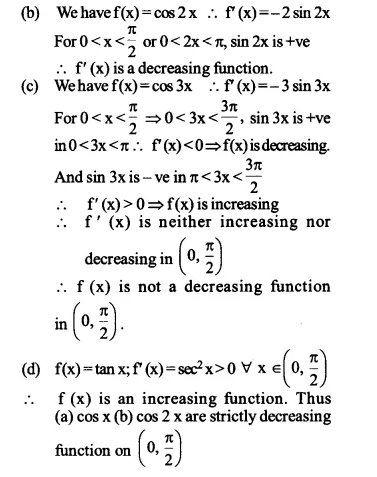
Ex 6.2 Class 12 Maths Question 13.
On which of the following intervals is the function f given by f (x )= x100 + sin x – 1 strictly decreasing ?
(a) (0,1)
(b) \(\left[ \frac { \pi }{ 2 } ,\pi \right] \)
(c) \(\left[ 0,\frac { \pi }{ 2 } \right] \)
(d) none of these
Solution.
(d) f(x) = x100 + sin x – 1
∴ f’ (x)= 100x99+ cos x
(a) for(-1, 1)i.e.,- 1 <x< 1,-1 <x99< 1
⇒ -100<100x99<100;
Also 0 ⇒ f’ (x) can either be +ve or -ve on(-1, 1)
∴ f (x) is neither increasing nor decreasing on (-1,1).
(b) for (0,1) i.e. 0<x< 1 x99 and cos x are both +ve ∴ f’ (x) > 0
⇒ f (x) is increasing on(0,1)

Ex 6.2 Class 12 Maths Question 14.
Find the least value of a such that the function f given by f (x) = x² + ax + 1 is strictly increasing on (1,2).
Solution.
We have f (x) = x² + ax + 1
∴ f’ (x) = 2x + a.
Since f (x) is an increasing function on (1,2)
f’ (x) > 0 for all 1 < x < 2 Now, f” (x) = 2 for all x ∈ (1,2) ⇒ f” (x) > 0 for all x ∈ (1,2)
⇒ f’ (x) is an increasing function on (1,2)
⇒ f’ (x) is the least value of f’ (x) on (1,2)
But f’ (x)>0 ∀ x∈ (1,2)
∴ f’ (1)>0 =>2 + a>0
⇒ a > – 2 : Thus, the least value of a is – 2.
Ex 6.2 Class 12 Maths Question 15.
Let I be any interval disjoint from (-1,1). Prove that the function f given by \(f(x)=x+\frac { 1 }{ x } \) is strictly increasing on I.
Solution.
Given
\(f(x)=x+\frac { 1 }{ x } \)

Hence, f’ (x) is strictly increasing on I.
Ex 6.2 Class 12 Maths Question 16.
Prove that the function f given by f (x) = log sin x is strictly increasing on \(\left( 0,\frac { \pi }{ 2 } \right) \) and strictly decreasing on
\(\left( \frac { \pi }{ 2 } ,\pi \right) \)
Solution.
f’ (x) = \(\frac { 1 }{ sin\quad x } .cos\quad x\quad cot\quad x\quad \)
when 0 < x < \(\frac { \pi }{ 2 } \), f’ (x) is +ve; i.e., increasing
When \(\frac { \pi }{ 2 } \) < x < π, f’ (x) is – ve; i.e., decreasing,
∴ f (x) is decreasing. Hence, f is increasing on (0, π/2) and strictly decreasing on (π/2, π).
Ex 6.2 Class 12 Maths Question 17.
Prove that the function f given by f(x) = log cos x is strictly decreasing on \(\left( 0,\frac { \pi }{ 2 } \right) \) and strictly increasing on \(\left( \frac { \pi }{ 2 } ,\pi \right) \)
Solution.
\(f(x)=log\quad cosx\)
f’ (x) = \(\frac { 1 }{ cosx } (-sinx)=-tanx\)
In the interval \(\left( 0,\frac { \pi }{ 2 } \right) \) ,f’ (x) = -ve
∴ f is strictly decreasing.
In the interval \(\left( \frac { \pi }{ 2 } ,\pi \right) \), f’ (x) is + ve.
∴ f is strictly increasing in the interval.
Ex 6.2 Class 12 Maths Question 18.
Prove that the function given by
f (x) = x3 – 3x2 + 3x -100 is increasing in R.
Solution.
f’ (x) = 3x2 – 6x + 3
= 3 (x2 – 2x + 1)
= 3 (x -1 )2
Now x ∈ R, f'(x) = (x – 1)2≥0
i.e. f'(x)≥0 ∀ x∈R; hence, f(x) is increasing on R.
Ex 6.2 Class 12 Maths Question 19.
The interval in which y = x2 e-x is increasing is
(a) (-∞,∞)
(b) (-2,0)
(c) (2,∞)
(d) (0,2)
Solution.
(d) f’ (x) = 2xe-x + x2( – e-x) = xe-x(2-x) = e-xx(2-x)
Now e-x is positive for all x ∈ R f’ (x) = 0 at x = 0,2
x = 0, x = 2 divide the number line into three disjoint intervals, viz. (-∞, 0), (0,2), (2, ∞)
(a) Interval (-∞,0) x is +ve and (2-x) is +ve
∴ f’ (x) = e-xx (2- x)=(+)(-) (+) = -ve
⇒ f is decreasing in (-∞,0)
(b) Interval (0,2) f’ (x) = e-x x (2 – x)
= (+)(+)(+) = +ve
⇒ f is increasing in (0,2)
(c) Interval (2, ∞) f’ (x) = e-x x (2 – x) = (+) (+) (-)
= – ve
⇒ f is decreasing in the interval (2, ∞)
NCERT Solutions for Class 12 Maths Chapter 6 Application of Derivatives Ex 6.3
Ex 6.3 Class 12 Maths Question 1.
Find the slope of the tangent to the curve y = 3x4 – 4x at x = 4.
Solution.
The curve is y = 3x4 – 4x
∴\(\frac { dy }{ dx }\) = 12x3 – 4
∴Req. slope = \({ \left( \frac { dy }{ dx } \right) }_{ x=4 }\)
= 12 x 43 – 4 = 764.
Ex 6.3 Class 12 Maths Question 2.
Find the slope of the tangent to the curve \(y=\frac { x-1 }{ x-2 } ,x\neq 2\) at x = 10.
Solution.
The curve is \(y=\frac { x-1 }{ x-2 } \)
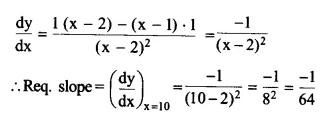
Ex 6.3 Class 12 Maths Question 3.
Find the slope of the tangent to curve y = x3 – x + 1 at the point whose x-coordinate is 2.
Solution.
The curve is y = x3 – x + 1
\(\frac { dy }{ dx }\) = 3x² – 1
∴slope of tangent = \({ \left( \frac { dy }{ dx } \right) }_{ x=2 }\)
= 3 x 2² – 1
= 11
Ex 6.3 Class 12 Maths Question 4.
Find the slope of the tangent to the curve y = x3 – 3x + 2 at the point whose x-coordinate is 3.
Solution.
The curve is y = x3 – 3x + 2
\(\frac { dy }{ dx }\) = 3x² – 3
∴slope of tangent = \({ \left( \frac { dy }{ dx } \right) }_{ x=3 }\)
= 3 x 3² – 3
= 24
Ex 6.3 Class 12 Maths Question 5.
Find the slope of the normal to the curve x = a cos3 θ, y = a sin3 θ at θ = \(\frac { \pi }{ 4 } \) .
Solution.
\(\frac { dx }{ d\theta } =-3a\quad { cos }^{ 2 }\theta sin\theta ,\frac { dy }{ d\theta } =3a\quad { sin }^{ 2 }\theta cos\theta \)

Ex 6.3 Class 12 Maths Question 6.
Find the slope of the normal to the curve x = 1 – a sin θ, y = b cos² θ at θ = \(\frac { \pi }{ 2 } \)
Solution.
\(\frac { dx }{ d\theta } =-a\quad cos\theta \quad \& \quad \frac { dy }{ d\theta } =2b\quad cos\theta (-sin\theta )\)
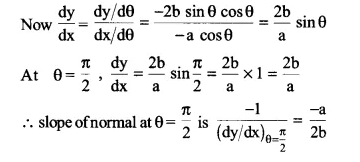
Ex 6.3 Class 12 Maths Question 7.
Find points at which the tangent to the curve y = x3 – 3x2 – 9x + 7 is parallel to the x-axis.
Solution.
Differentiating w.r.t. x; \(\frac { dy }{ dx }\) = 3 (x – 3) (x + 1)
Tangent is parallel to x-axis if the slope of tangent = 0
or \(\frac { dy }{ dx }=0\)
⇒3(x + 3)(x + 1) = 0
⇒x = -1, 3
when x = -1, y = 12 & When x = 3, y = – 20
Hence the tangent to the given curve are parallel to x-axis at the points (-1, -12), (3, -20)
Ex 6.3 Class 12 Maths Question 8.
Find a point on the curve y = (x – 2)² at which the tangent is parallel to the chord joining the points (2,0) and (4,4).
Solution.
The equation of the curve is y = (x – 2)²
Differentiating w.r.t x
\(\frac { dy }{ dx }=2(x-2)\)
The point A and B are (2,0) and (4,4) respectively.
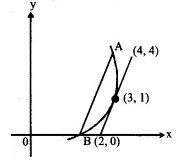
Slope of AB = \(\frac { { y }_{ 2 }-{ y }_{ 1 } }{ { x }_{ 2 }-{ x }_{ 1 } } =\frac { 4-0 }{ 4-2 } =\frac { 4 }{ 2 } \) = 2 …(i)
Slope of the tangent = 2 (x – 2) ….(ii)
from (i) & (ii) 2 (x – 2)=2
∴ x – 2 = 1 or x = 3
when x = 3,y = (3 – 2)² = 1
∴ The tangent is parallel to the chord AB at (3,1)
Ex 6.3 Class 12 Maths Question 9.
Find the point on the curve y = x3 – 11x + 5 at which the tangent is y = x – 11.
Solution.
Here, y = x3 – 11x + 5
⇒ \(\frac { dy }{ dx }\) = 3x² – 11
The slope of tangent line y = x – 11 is 1
∴ 3x² – 11 = 1
⇒ 3x² = 12
⇒ x² = 4, x = ±2
When x = 2, y = – 9 & when x = -2,y = -13
But (-2, -13) does not lie on the curve
∴ y = x – 11 is the tangent at (2, -9)
Ex 6.3 Class 12 Maths Question 10.
Find the equation of all lines having slope -1 that are tangents to the curve \(y=\frac { 1 }{ x-1 }\), x≠1
Solution.
Here
\(y=\frac { 1 }{ x-1 }\)
⇒ \(\frac { dy }{ dx } =\frac { -1 }{ { (x-1) }^{ 2 } } \)

Ex 6.3 Class 12 Maths Question 11.
Find the equation of ail lines having slope 2 which are tangents to the curve \(y=\frac { 1 }{ x-3 }\), x≠3.
Solution.
Here
\(y=\frac { 1 }{ x-3 }\)
\(\frac { dy }{ dx } ={ (-1)(x-3) }^{ -2 }=\frac { -1 }{ { (x-3) }^{ 2 } } \)
∵ slope of tangent = 2
\(\frac { -1 }{ { (x-3) }^{ 2 } } =2\Rightarrow { (x-3) }^{ 2 }=-\frac { 1 }{ 2 } \)
Which is not possible as (x – 3)² > 0
Thus, no tangent to \(y=\frac { 1 }{ x-3 }\) has slope 2.
Ex 6.3 Class 12 Maths Question 12.
Find the equations of all lines having slope 0 which are tangent to the curve \(y=\frac { 1 }{ { x }^{ 2 }-2x+3 } \)
Solution.
Let the tangent at the point (x1, y1) to the curve
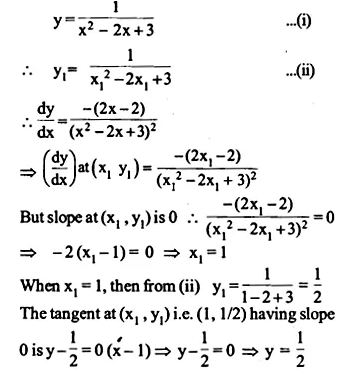
Ex 6.3 Class 12 Maths Question 13.
Find points on the curve \(\frac { { x }^{ 2 } }{ 9 } +\frac { { y }^{ 2 } }{ 16 } =1\) at which the tangents are
(a) parallel to x-axis
(b) parallel to y-axis
Solution.
The equation of the curve is \(\frac { { x }^{ 2 } }{ 9 } +\frac { { y }^{ 2 } }{ 16 } =1\)…(i)

Ex 6.3 Class 12 Maths Question 14.
Find the equations of the tangent and normal to the given curves at the indicated points:
(i) y = x4 – 6x3 + 13x2 – 10x + 5 at (0,5)
(ii) y = x4 – 6x3 + 13x2 – 10x + 5 at (1,3)
(iii) y = x3 at (1, 1)
(iv) y = x2 at (0,0)
(v) x = cos t, y = sin t at t = \(\frac { \pi }{ 4 } \)
Solution.
\(\frac { dy }{ dx } ={ 4x }^{ 3 }-18{ x }^{ 2 }+26x-10\)
Putting x = 0, \(\frac { dy }{ dx } \) at (0,5) = – 10
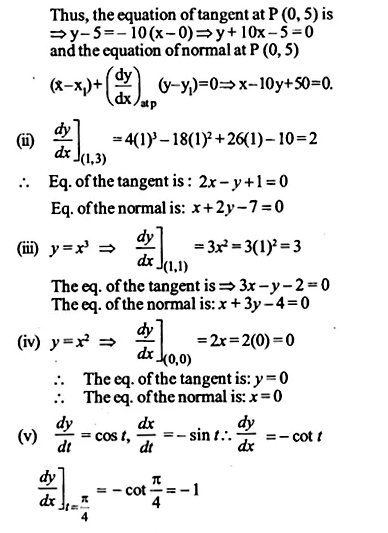

Ex 6.3 Class 12 Maths Question 15.
Find the equation of the tangent line to the curve y = x2 – 2x + 7 which is
(a) parallel to the line 2x – y + 9 = 0
(b) perpendicular to the line 5y – 15x = 13.
Solution.
Equation of the curve is y = x² – 2x + 7 …(i)
\(\frac { dy }{ dx } \) = 2x – 2 = 2(x – 1)
(a) Slope of the line 2x – y + 9 = 0 is 2
⇒ Slope of tangent = \(\frac { dy }{ dx } \) = 2(x – 1) = 2
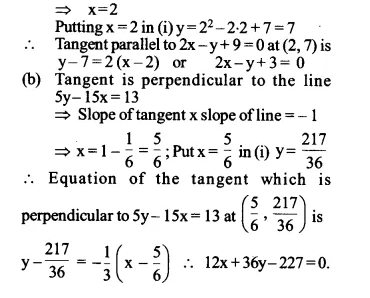
Ex 6.3 Class 12 Maths Question 16.
Show that the tangents to the curve y = 7x3 + 11 at the points where x = 2 and x = – 2 are parallel.
Solution.
Here, y = 7x3 + 11
=> x \(\frac { dy }{ dx }\) = 21 x²
Now m1 = slope at x = 2 is \({ \left( \frac { dy }{ dx } \right) }_{ x=2 }\) = 21 x 2² = 84
and m2 = slope at x = -2 is \({ \left( \frac { dy }{ dx } \right) }_{ x=-2 }\) = 21 x (-2)² = 84
Hence, m1 = m2 Thus, the tangents to the given curve at the points where x = 2 and x = – 2 are parallel
Ex 6.3 Class 12 Maths Question 17.
Find the points on the curve y = x3 at which the slope of the tangent is equal to the y-coordinate of the point
Solution.
Let P (x1, y1) be the required point.
The given curve is: y = x3

Ex 6.3 Class 12 Maths Question 18.
For the curve y = 4x3 – 2x5, find all the points at which the tangent passes through the origin.
Solution.
Let (x1, y1) be the required point on the given curve y = 4x3 – 2x5, then y1 = 4x13 – 2x15 …(i)
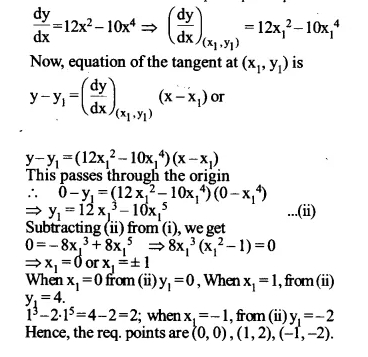
Ex 6.3 Class 12 Maths Question 19.
Find the points on the curve x2 + y2 – 2x – 3 = 0 at which the tangents are parallel to the x-axis.
Solution.
Here, x2 + y2 – 2x – 3 = 0
=> \(\frac { dy }{ dx } =\frac { 1-x }{ y } \)
Tangent is parallel to x-axis, if \(\frac { dy }{ dx }=0\) i.e.
if 1 – x = 0
⇒ x = 1
Putting x = 1 in (i)
⇒ y = ±2
Hence, the required points are (1,2), (1, -2) i.e. (1, ±2).
Ex 6.3 Class 12 Maths Question 20.
Find the equation of the normal at the point (am2, am3) for the curve ay2 = x3.
Solution.
Here, ay2 = x3
\(2ay\frac { dy }{ dx } ={ 3x }^{ 2 }\Rightarrow \frac { dy }{ dx } =\frac { { 3x }^{ 2 } }{ 2ay } \)
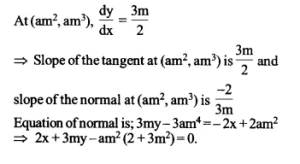
Ex 6.3 Class 12 Maths Question 21.
Find the equation of the normal’s to the curve y = x3 + 2x + 6 which are parallel to the line x + 14y + 4 = 0.
Solution.
Let the required normal be drawn at the point (x1, y1)
The equation of the given curve is y = x3 + 2x + 6 …(i)
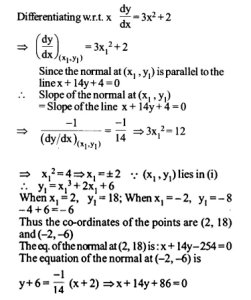
Ex 6.3 Class 12 Maths Question 22.
Find the equations of the tangent and normal to the parabola y² = 4ax at the point (at²,2at).
Solution.
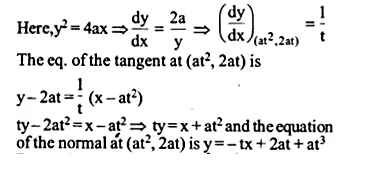
Ex 6.3 Class 12 Maths Question 23.
Prove that the curves x = y² and xy = k cut at right angles if 8k² = 1.
Solution.
The given curves are x = y² …(i)
and xy = k …(ii)

Ex 6.3 Class 12 Maths Question 24.
Find the equations of the tangent and normal to the hyperbola \(\frac { { x }^{ 2 } }{ { a }^{ 2 } } -\frac { { y }^{ 2 } }{ { b }^{ 2 } } =1\) at the point (x0 ,y0).
Solution.
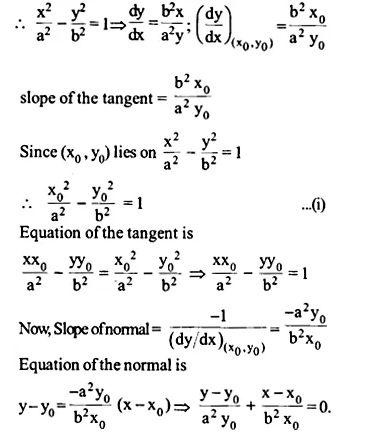
Ex 6.3 Class 12 Maths Question 25.
Find the equation of the tangent to the curve \(y=\sqrt { 3x-2 } \) which is parallel to the line 4x – 2y + 5 = 0.
Solution.
Let the point of contact of the tangent line parallel to the given line be P (x1, y1) The equation of the curve is \(y=\sqrt { 3x-2 } \)
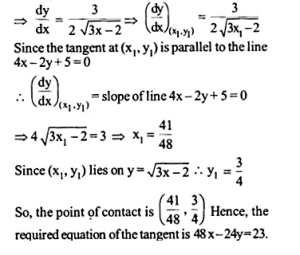
Choose the correct answer in Exercises 26 and 27.
Ex 6.3 Class 12 Maths Question 26.
The slope of the normal to the curve y = 2x² + 3 sin x at x = 0 is
(a) 3
(b) \(\frac { 1 }{ 3 }\)
(c) -3
(d) \(-\frac { 1 }{ 3 }\)
Solution.
(d) ∵ y = 2x² + 3sinx
∴\(\frac { dy }{ dx }=4x+3cosx\) at
x = 0,\(\frac { dy }{ dx }=3\)
∴ slope = 3
⇒ slope of normal is = \(\frac { 1 }{ 3 }\)
Ex 6.3 Class 12 Maths Question 27.
The line y = x + 1 is a tangent to the curve y² = 4x at the point
(a) (1,2)
(b) (2,1)
(c) (1,-2)
(d) (-1,2)
Solution.
(a) The curve is y² = 4x,
∴ \(\frac { dy }{ dx } =\frac { 4 }{ 2y } =\frac { 2 }{ y } \)
Slope of the given line y = x + 1 is 1 ∴ \(\frac { 2 }{ y }=1\)
y = 2 Putting y= 2 in y² = 4x 2² = 4x
⇒ x = 1
∴ Point of contact is (1,2)
NCERT Solutions for Class 12 Maths Chapter 6 Application of Derivatives Ex 6.4
Ex 6.4 Class 12 Maths Question 1.
Using differentials, find the approximate value of each of the following up to 3 places of decimal.
(i) \(\sqrt { 25.3 } \)
(ii) \(\sqrt { 49.5 } \)
(iii) \(\sqrt { 0.6 } \)
(iv) \({ \left( 0.009 \right) }^{ \frac { 1 }{ 3 } }\)
(v) \({ \left( 0.999 \right) }^{ \frac { 1 }{ 10 } }\)
(vi) \({ \left( 15 \right) }^{ \frac { 1 }{ 4 } }\)
(vii) \({ \left( 26 \right) }^{ \frac { 1 }{ 3 } }\)
(viii) \({ \left( 255 \right) }^{ \frac { 1 }{ 4 } }\)
(ix) \({ \left( 82 \right) }^{ \frac { 1 }{ 4 } }\)
(x) \({ \left( 401 \right) }^{ \frac { 1 }{ 2 } }\)
(xi) \({ \left( 0.0037 \right) }^{ \frac { 1 }{ 2 } }\)
(xii) \({ \left( 26.57 \right) }^{ \frac { 1 }{ 3 } }\)
(xiii) \({ \left( 81.5 \right) }^{ \frac { 1 }{ 4 } }\)
(xiv) \({ \left( 3.968 \right) }^{ \frac { 3 }{ 2 } }\)
(xv) \({ \left( 32.15 \right) }^{ \frac { 1 }{ 5 } }\)
Solution.
(i) y + ∆y = \(\sqrt { 25.3 } \)
= \(\sqrt { 25+0.3 } \)
= \(\sqrt { x+\Delta x } \)
∴ x = 25
∆x = 0.3
⇒ y = √x
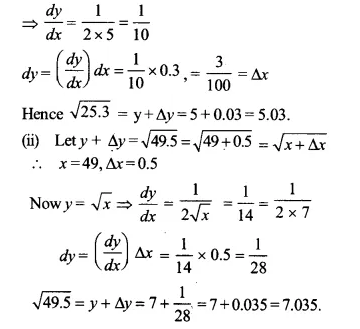
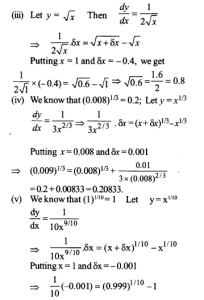
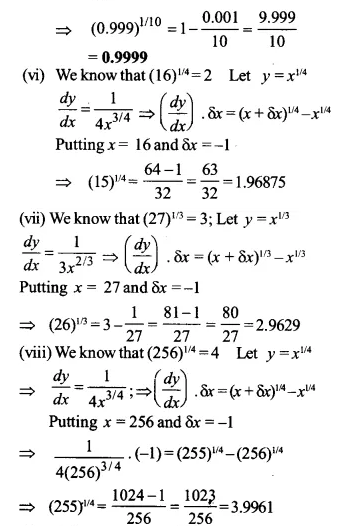
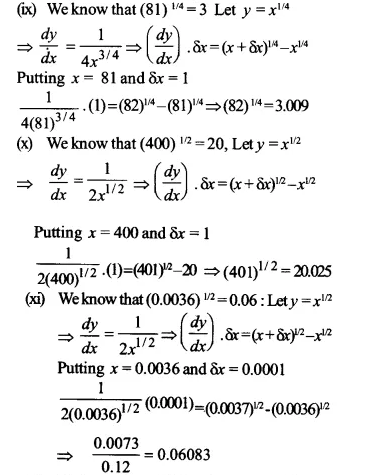

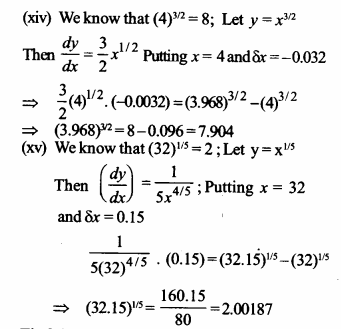
Ex 6.4 Class 12 Maths Question 2.
Find the approximate value of f (2.01), where f (x) = 4x² + 5x + 2
Solution.
f(x+∆x) = f(2.01), f(x) = f (2) = 4.2² + 5.2 + 2 = 28,
f’ (x) = 8x + 5 Now, f(x + ∆x) = f(x) + ∆f(x)
= f(x) + f’ (x) • ∆x = 28 + (8x + 5) ∆x
= 28 + (16 + 5) x 0.01
= 28 + 21 x 0.01
= 28 + 0.21
Hence,f(2 x 01)
= 28 x 21.
Ex 6.4 Class 12 Maths Question 3.
Find the approximate value of f (5.001), where f(x) = x3 – 7x2 +15.
Solution.
Let x + ∆x = 5.001, x = 5 and ∆x = 0.001,
f(x) = f(5) = – 35
f(x + ∆x) = f(x) + ∆f(x) = f(x) + f'(x).∆x
= (x3 – 7x² + 15) + (3x² – 14x) × ∆x
f(5.001) = – 35 + (3 × 5² – 14 × 5) × 0.001
⇒ f (5.001) = – 35 + 0.005
= – 34.995.
Ex 6.4 Class 12 Maths Question 4.
Find the approximate change in the volume V of a cube of side x metres caused by increasing the side by 1%.
Solution.
The side of the cube = x meters.
Increase in side = 1% = 0.01 × x = 0.01 x
Volume of cube V= x3
∴ ∆v =\(\frac { dv }{ dx }\) × ∆x
= 3x² × 0.01 x
= 0.03 x3 m3
Ex 6.4 Class 12 Maths Question 5.
Find the approximate change in the surface area of a cube of side x metres caused by decreasing the side by 1%.
Solution.
The side of the cube = x m;
Decrease in side = 1% = 0.01 x
Increase in side = ∆x = – 0.01 x
Surface area of cube = 6x² m² = S
∴ \(\frac { ds }{ dx }\) × ∆x = 12x × (- 0.01 x)
= – 0.12 x² m².
Ex 6.4 Class 12 Maths Question 6.
If the radius of a sphere is measured as 7m with an error of 0.02 m, then find the approximate error in calculating its volume.
Solution.
Radius of the sphere = 7m : ∆r = 0.02 m.
Volume of the sphere V = \(\frac { 4 }{ 3 } \pi { r }^{ 3 }\)
\(\Delta V=\frac { dV }{ dr } \times \Delta r=\frac { 4 }{ 3 } .\pi .3{ r }^{ 2 }\times \Delta r\)
= 4π × 7² × 0.02
= 3.92 πm³
Ex 6.4 Class 12 Maths Question 7.
If the radius of a sphere is measured as 9 m with an error of 0.03 m, then find the approximate error in calculating its surface area.
Solution.
Radius of the sphere = 9 m: ∆r = 0.03m
Surface area of sphere S = 4πr²
∆s = \(\frac { ds }{ dr }\) × ∆r
= 8πr × ∆r
= 8π × 9 × 0.03
= 2.16 πm².
Ex 6.4 Class 12 Maths Question 8.
If f (x) = 3x² + 15x + 5, then the approximate value of f (3.02) is
(a) 47.66
(b) 57.66
(c) 67.66
(d) 77.66
Solution.
(d) x + ∆x = 3.02, where x=30, ∆x=.02,
∆f(x) = f(x + ∆x) – f(x)
⇒ f(x + ∆x) = f(x) + ∆f(x) = f(x) + f’ (x)∆x
Now f(x) = 3×2 + 15x + 5; f(3) = 77, f’ (x) = 6x + 15
f’ (3) = 33
∴ f (3.02) = 87 + 33 x 0 02 = 77.66
Ex 6.4 Class 12 Maths Question 9.
The approximate change in the volume of a cube of side x metres caused by increasing the side by 3% is
(a) 0.06 x³ m³
(b) 0.6 x³ m³
(c) 0.09 x³ m³
(d) 0.9 x³ m³
Solution.
(c) Side of a cube = x meters
Volume of cube = x³,
for ∆x. ⇒ 3% of x = 0.03 x
Let ∆v be the change in v0l. ∆v = \(\frac { dv }{ dx }\) x ∆x = 3x² × ∆x
But, ∆x = 0.03 x
⇒ ∆v = 3x² x 0.03 x
= 0.09 x³m³
NCERT Solutions for Class 12 Maths Chapter 6 Application of Derivatives Ex 6.5
Ex 6.5 Class 12 Maths Question 1.
Find the maximum and minimum values, if any, of the following functions given by
(i) f(x) = (2x – 1)² + 3
(ii) f(x) = 9x² + 12x + 2
(iii) f(x) = – (x – 1)² + 10
(iv) g(x) = x3 + 1
Solution.
(i) Minimum value of (2x – 1)² is zero.
Minimum value of (2x – 1)² + 3 is 3
Clearly it does not have maximum value,
(ii) f(x) = 9x² + 12x + 2
⇒ f(x) = (3x + 2)² – 2
Minimum value of (3 + 2)² is zero.
∴ Min.value of (3x + 2)² – 2 = 9x² + 12x + 2 is – 2
f (x) does not have finite maximum value
(iii) f(x) = – (x – 1)² + 10
Maximum value of – (x – 1)² is zero
Maximum valuer f f(x) = – (x – 1)² + 10 is 10
f (x) does not have finite minimum value.
(iv) As x—»∞,g(x)—»∞;Also x—»-∞,g(x)—»-∞
Thus there is no maximum or minimum value of f(x)
Ex 6.5 Class 12 Maths Question 2.
Find the maximum and minimum values, if any, of the following functions given by
(i) f(x) = |x + 2| – 1
(ii) g(x) = -|x + 1| + 3
(iii) h (x) = sin 2x + 5
(iv) f(x) = |sin(4x + 3)|
(v) h(x) = x + 1,x∈(-1,1)
Solution.
(i) We have :f(x) = |x + 2 |-1 ∀x∈R
Now |x + 2|≥0∀x∈R
|x + 2| – 1 ≥ – 1 ∀x∈R ,
So -1 is the min. value of f(x)
now f(x) = -1
⇒ |x + 2|-1
⇒ |x + 2| = 0
⇒ x = – 2
(ii) We have g(x) = -|x + 1| + 3 ∀x∈R
Now | x + 1| ≥ 0 ∀x∈R
-|x+ 1| + 3 ≤3 ∀x∈R
So 3 is the minimum value of f(x).
Now f(x) = 3
⇒ -|x+1| + 3
⇒ |x+1| = 0
⇒ x = – 1.
(iii) Thus maximum value of f(x) is 6 and minimum value is 4.
(iv) Let f(x) = |sin4x + 3|
Maximum value of sin 4x is 1
∴ Maximum value of |sin(4x+3)| is |1+3| = 4
Minimum value of sin 4x is -1
∴ Minimum value of f(x) is |-1+3| = |2|= 2
(v) Greatest value of f (x) is 2 and least value is 0.
Ex 6.5 Class 12 Maths Question 3.
Find the local maxima and local minima, if any, of the following functions. Find also the local maximum and the local minimum values, as the case may be:
(i) f(x) = x2
(ii) g(x) = x3 – 3x
(iii) h(x) = sinx+cosx,0<x<\(\frac { \pi }{ 4 } \)
(iv) f(x) = sin4x + cos4x,0<x<\(\frac { \pi }{ 2 } \)
(v) f(x) = x3 – 6x2 + 9x:+15
(vi) g(x) = \(\frac { x }{ 2 } +\frac { 2 }{ x } \), x>0
(vii) g(x) = \(\frac { 1 }{ { x }^{ 2 }+2 } \), x>0
(viii) f(x) = \(x\sqrt { 1-x } \), x>0
Solution.
(i) Let f(x) = x² ⇒ f’(x) = 2x
Now f'(x) = 0 ⇒ 2x = 0 i.e., x = 0
At x = 0; When x is slightly < 0, f’ (x) is -ve When x is slightly > 0, f(x) is +ve
∴ f(x) changes sign from -ve to +ve as x increases through 0.
⇒ f’ (x) has a local minimum at x = 0 local minimum value f(0) = 0.
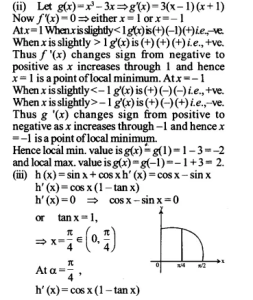
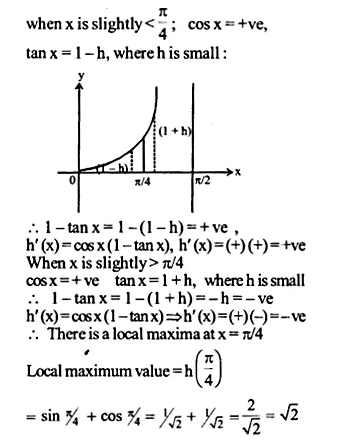
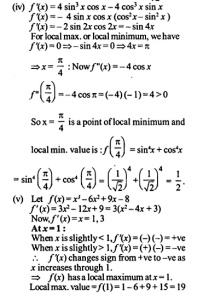
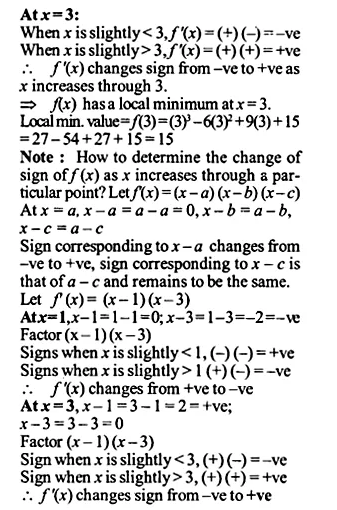
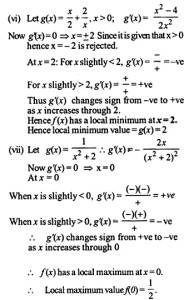
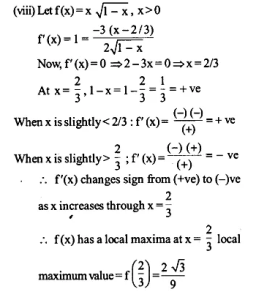
Ex 6.5 Class 12 Maths Question 4.
Prove that the following functions do not have maxima or minima:
(i) f(x) = ex
(ii) f(x) = log x
(iii) h(x) = x3 + x2 + x + 1
Solution.
(i) f'(x) = ex;
Since f’ (x) ≠ 0 for any value of x.
So f(x) = ex does not have a max. or min.
(ii) f’ (x) = \(\frac { 1 }{ x }\); Clearly f’ (x) ≠ 0 for any value of x.
So,f’ (x) = log x does not have a maximum or a minimum.
(iii) We have f(x) = x3 + x2 + x + 1
⇒f’ (x) = 3x2 + 2x + 1
Now, f’ (x) = 0 => 3x2 + 2x + 1 = 0
\(x=\frac { -2\pm \sqrt { 4-12 } }{ 6 } =\frac { -1+\sqrt { -2 } }{ 3 } \)
i.e. f'(x) = 0 at imaginary points
i.e. f'(x) ≠ 0 for any real value of x
Hence, there is neither max. nor min.
Ex 6.5 Class 12 Maths Question 5.
Find the absolute maximum value and the absolute minimum value of the following functions in the given intervals:
(i) f(x) = x3, x∈ [-2,2]
(ii) f(x) = sin x + cos x, x ∈ [0, π]
(iii) f(x) = \(4x-\frac { 1 }{ 2 } { x }^{ 2 },x\in \left[ -2,\frac { 9 }{ 2 } \right] \)
(iv) f(x) = \({ (x-1) }^{ 2 }+3,x\in \left[ -3,1 \right] \)
Solution.
(i) We have f’ (x) = x3 in [ -2,2]
∴ f'(x) = 3x²; Now, f’ (x) = 0 at x = 0, f(0) = 0
Now, f(-2) = (-2)3 = – 8; f(0) = (0)² = 0 and f(0) = (2) = 8
Hence, the absolute maximum value of f (x) is 8 which it attained at x = 2 and absolute minimum value of f(x) = – 8 which is attained at x = -2.
(ii) We have f (x) = sin x + cos x in [0, π]
f’ (x) = cos x – sin x for extreme values f’ (x) = 0

Ex 6.5 Class 12 Maths Question 6.
Find the maximum profit that a company can make, if the profit function is given by p(x) = 41 – 24x – 18x²
Solution.
Profit function in p(x) = 41 – 24x – 18x²
∴ p'(x) = – 24 – 36x = – 12(2 + 3x)
for maxima and minima, p'(x) = 0
Now, p'(x) = 0
⇒ – 12(2 + 3x) = 0
⇒ x = \(-\frac { 2 }{ 3 }\),
p'(x) changes sign from +ve to -ve.
⇒ p (x) has maximum value at x = \(-\frac { 2 }{ 3 }\)
Maximum Profit = 41 + 16 – 8 = 49.
Ex 6.5 Class 12 Maths Question 7.
Find both the maximum value and the minimum value of 3x4 – 8x3 + 12x2 – 48x + 25 on the interval [0,3].
Solution.
Let f(x) = 3x4 – 8x3 + 12x2 – 48x + 25
∴f'(x) = 12x3 – 24x2 + 24x – 48
= 12(x2 + 2)(x – 2)
For maxima and minima, f'(x) = 0
⇒ 12(x2 + 2)(x – 2) = 0
⇒ x = 2
Now, we find f (x) at x = 0,2 and 3, f (0) = 25,
f (2) = 3 (24) – 8 (23) + 12 (22) – 48 (2) + 25 = – 39
and f (3) = (34) – 8 (33) + 12 (32) – 48 (3) + 25
= 243 – 216 + 108 – 144 + 25 = 16
Hence at x = 0, Maximum value = 25
at x = 2, Minimum value = – 39.
Ex 6.5 Class 12 Maths Question 8.
At what points in the interval [0,2π], does the function sin 2x attain its maximum value?
Solution.
We have f (x) = sin 2x in [0,2π], f’ (x) = 2 cos 2 x
For maxima and minima f’ (x) = 0 => cos 2 x = 0

Ex 6.5 Class 12 Maths Question 9.
What is the maximum value of the function sin x + cos x?
Solution.
Consider the interval [0, 2π],
Let f(x) = sinx + cosx,
f’ (x) = cosx – sinx
For maxima and minima, f’ (x) = 0
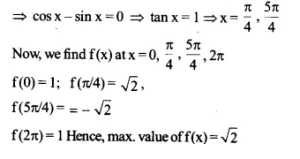
Ex 6.5 Class 12 Maths Question 10.
Find the maximum value of 2x3 – 24x + 107 in the interval [1,3]. Find the maximum value of the same function in [-3, -1].
Solution.
∵ f(x) = 2x3 – 24x + 107
∴f(x) = 6x2 – 24 ,
For maxima and minima f'(x) = 0;⇒ x = ±2
For the interval [ 1,3], we find the values of f (x)
at x = 1,2,3; f(1) = 85, f(2) = 75, f(3) = 89
Hence, maximum f (x) = 89 at x = 3
For the interval [-3, -1], we find the values of f(x) at x = – 3, – 2, – 1;
f(-3) = 125;
f(-2) = 139
f(-1) = 129
∴ max.f(x) = 139 at x = – 2.
Ex 6.5 Class 12 Maths Question 11.
It is given that at x = 1, the function x4 – 62x2 + ax + 9 attains its maximum value, on the interval [0,2]. Find the value of a.
Solution.
∵ f(x) = x4 – 62x2 + ax + 9
∴ f’ (x) = 4x3 – 124x + a
Now f’ (x) = 0 at x = 1
⇒ 4 – 124 + a = 0
⇒ a = 120
Now f” (x) = 12x2 – 124:
At x = 1 f” (1) = 12 – 124 = – 112 < 0
⇒ f(x) has a maximum at x = 1 when a = 120.
Ex 6.5 Class 12 Maths Question 12.
Find the maximum and minimum values of x + sin 2x on [0,2π]
Solution.
∴f(x) = x + sin2x on[0,2π]
∴f’ (x) = 1+2 cos2x
For maxima and minima f’ (x) = 0

Ex 6.5 Class 12 Maths Question 13.
Find two numbers whose sum is 24 and whose product is as large as possible.
Solution.
Let the required numbers hex and (24-x)
∴Their product,p = x(24 – x) = 24x – x²
Now \(\frac { dp }{ dx }\) = 0 ⇒24 – 2x = 0 ⇒ x = 12
Also \(\frac { { d }^{ 2 }p }{ { dx }^{ 2 } } \) = -2<0: ⇒ p is max at x = 12
Hence, the required numbers are 12 and (24-12)i.e. 12.
Ex 6.5 Class 12 Maths Question 14.
Find two positive numbers x and y such that x + y = 60 and xy3 is maximum.
Solution.
We have x + y = 60
⇒ y = 60 – x …(i)

Hence, the req. numbers are 15 and (60 -15) i.e. 15 and 45.
Ex 6.5 Class 12 Maths Question 15.
Find two positive numbers x and y such that their sum is 35 and the product x2 y5 is a maximum.
Solution.
We have x + y = 35 ⇒ y = 35 – x
Product p = x2 y5
= x2 (35 – x)5

Ex 6.5 Class 12 Maths Question 16.
Find two positive numbers whose sum is 16 and the sum of whose cubes is minimum.
Solution.
Let two numbers be x and 16 – x

Hence, the required numbers are 8 and (16-8) i.e. 8 and 8.
Ex 6.5 Class 12 Maths Question 17.
A square piece of tin of side 18 cm is to be made into a box without top, by cutting a square from each corner and folding up the flaps to form the box. What should be the side of the square to be cut off so that the volume of the box is the maximum possible.
Solution.
Let each side of the square to be cut off be x cm.
∴ for the box length = 18 – 2x: breadth = 18 – 2x and height = x

Ex 6.5 Class 12 Maths Question 18.
A rectangular sheet of tin 45 cm by 24 cm is to be made into a box without top, by cutting off square from each comer and folding up the flaps. What should be the side of the square to be cut off so that the volume of the box is maximum?
Solution.
Let each side of the square cut off from each comer be x cm.
∴ Sides of the rectangular box are (45 – 2x), (24 – 2x) and x cm.
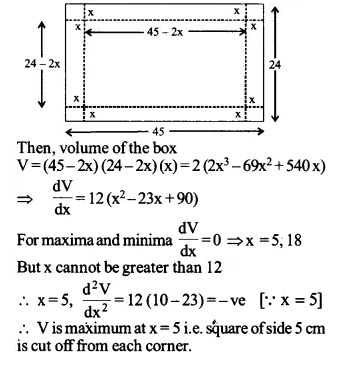
Ex 6.5 Class 12 Maths Question 19.
Show that of all the rectangles inscribed in a given fixed circle, the square has the maximum area.
Solution.
Let the length and breadth of the rectangle inscribed in a circle of radius a be x and y respectively.
∴ x² + y² = (2a)² => x² + y² = 4a² …(i)
∴ Perimeter = 2 (x + y)

Ex 6.5 Class 12 Maths Question 20.
Show that the right circular cylinder of given surface and maximum volume is such that its height is equal to the diameter of the base.
Solution.
Let S be the given surface area of the closed cylinder whose radius is r and height h let v be the its Volume. Then
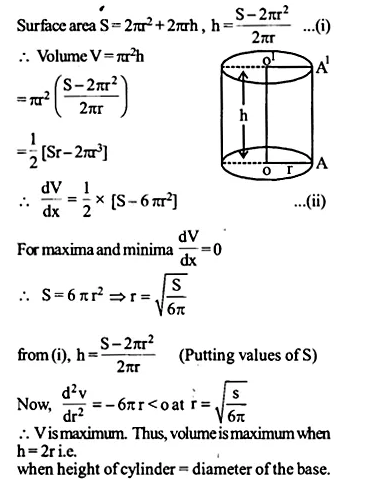
Ex 6.5 Class 12 Maths Question 21.
Of all the closed cylindrical cans (right circular), of a given volume of 100 cubic centimeters, find the dimensions of the can which has the minimum surface area ?
Solution.
Let r be the radius and h be the height of cylindrical can.

Ex 6.5 Class 12 Maths Question 22.
A wire of length 28 m is to be cut into two pieces. One of the pieces is to be made into a square and the other into a circle. What should be the length of the two pieces so that the combined area of the square and the circle is minimum ?
Solution.
Let one part be of length x, then the other part = 28 – x
Let the part of the length x be converted into a circle of radius r.


Ex 6.5 Class 12 Maths Question 23.
Prove that the volume of the largest cone that can be inscribed in a sphere of radius R is \(\frac { 8 }{ 27 }\) of the volume of the sphere.
Solution.
Let a cone. VAB of greatest volume be inscribed in the sphere let AOC = θ
∴ AC, radius of the base of the cone = R sin θ
and VC = VO + OC = R(1 +cosθ)
= R + Rcosθ
= height of the cone.,
V, the volume of the cone.
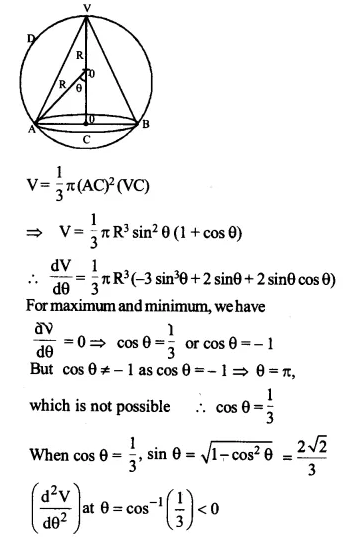
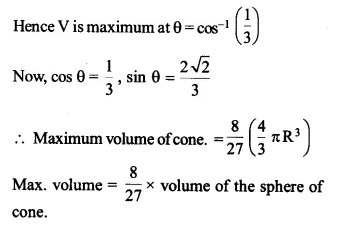
Ex 6.5 Class 12 Maths Question 24.
Show that die right circular cone of least curved surface and given volume has an altitude equal to √2 time the radius of the base.
Solution.
Let r and h be the radius and height of the cone.

Ex 6.5 Class 12 Maths Question 25.
Show that the semi-vertical angle of the cone of the maximum volume and of given slant height is tan-1 √2.
Solution.
Let v be the volume, l be the slant height and 0 be the semi vertical angle of a cone.

Ex 6.5 Class 12 Maths Question 26.
Show that semi-vertical angle of right circular cone of given surface area and maximum volume is \({ sin }^{ -1 }\left( \frac { 1 }{ 3 } \right) \)
Solution.
Let r be radius, l be the slant height and h be the height of the cone of given surface area s.Then

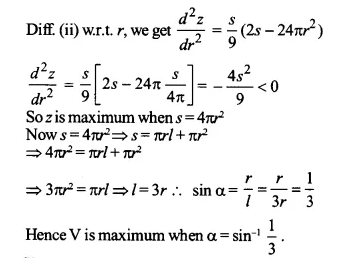
Choose the correct answer in the Exercises 27 and 29.
Ex 6.5 Class 12 Maths Question 27.
The point on die curve x² = 2y which is nearest to the point (0,5) is
(a) (2 √2,4)
(b) (2 √2,0)
(c) (0,0)
(d) (2,2)
Solution.
(a) Let P (x, y) be a point on the curve The other point is A (0,5)
Z = PA² = x² + y² + 25 – 10y [∵ x² = 2y]

Ex 6.5 Class 12 Maths Question 28.
For all real values of x, the minimum value of \(\frac { 1-x+{ x }^{ 2 } }{ 1+x+{ x }^{ 2 } } \)
(a) 0
(b) 1
(c) 3
(d) \(\frac { 1 }{ 3 }\)
Solution.
(d) Let \(y=\frac { 1-x+{ x }^{ 2 } }{ 1+x+{ x }^{ 2 } } \)

Ex 6.5 Class 12 Maths Question 29.
The maximum value of \({ \left[ x\left( x-1 \right) +1 \right] }^{ \frac { 1 }{ 3 } },0\le x\le 1\) is
(a) \({ \left( \frac { 1 }{ 3 } \right) }^{ \frac { 1 }{ 3 } } \)
(b) \(\frac { 1 }{ 2 } \)
(c) 1
(d) 0
Solution.
(c) Let y = \({ \left[ x\left( x-1 \right) +1 \right] }^{ \frac { 1 }{ 3 } },0\le x\le 1\)
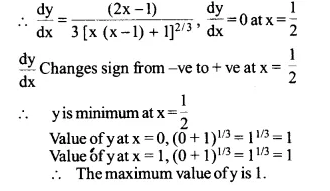
NCERT Class 12 Maths
Class 12 Maths Chapters | Maths Class 12 Chapter 6
Chapterwise NCERT Solutions for Class 12 Maths
-
NCERT Solutions For Class 12 Maths Chapter 1 Relations and Functions
NCERT Solutions For Class 12 Maths Chapter 2 Inverse Trigonometric Functions
NCERT Solutions For Class 12 Maths Chapter 3 Matrix
NCERT Solutions For Class 12 Maths Chapter 4 Determinants
NCERT Solutions For Class 12 Maths Chapter 5 Continuity and Differentiability
NCERT Solutions For Class 12 Maths Chapter 6 Application of Derivatives
NCERT Solutions For Class 12 Maths Chapter 7 Integrals
NCERT Solutions For Class 12 Maths Chapter 8 Application of Integrals
NCERT Solutions For Class 12 Maths Chapter 9 Differential Equations
NCERT Solutions For Class 12 Maths Chapter 10 Vector Algebra
NCERT Solutions For Class 12 Maths Chapter 11 Three-dimensional Geometry
NCERT Solutions For Class 12 Maths Chapter 12 Linear Programming
NCERT Solutions For Class 12 Maths Chapter 13 Probability
| NCERT Solutions for Class 12 All Subjects | NCERT Solutions for Class 10 All Subjects |
| NCERT Solutions for Class 11 All Subjects | NCERT Solutions for Class 9 All Subjects |

Post a Comment
इस पेज / वेबसाइट की त्रुटियों / गलतियों को यहाँ दर्ज कीजिये
(Errors/mistakes on this page/website enter here)